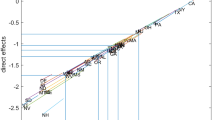Abstract
We study the local influence in the general spatial model which includes the spatial autoregressive model and the spatial error model as two special cases. The stepwise local influence procedure is employed in our diagnostic analysis. We derive the local diagnostic measures in the general spatial model under three perturbation schemes, namely, the variance perturbation, dependent variable perturbation and explanatory variable perturbation schemes. A simulation example and two real-data examples are analysed in detail and they show that the stepwise local influence analysis is effective in identifying influential observations and is a powerful tool for uncovering masking effects.





Similar content being viewed by others
References
Anselin, L.: Spatial econometrics: methods and models. Kluwer Academic Publishers, The Netherlands (1988)
Beckman, R.J., Nachtsheim, C.J., Cook, R.D.: Diagnostics for mixed-model analysis. Technometrics 29, 413–426 (1987)
Christensen, R., Johnson, W., Pearson, L.M.: Prediction diagnostics for spatial linear models. Biometrika 79(3), 583–591 (1992)
Cook, R.D.: Assessment of local influence. J. R. Stat. Soc. B 48, 133–169 (1986)
Cook, R.D., Weisberg, S.: Residuals and influence in regression. Chapman and Hall, New York (1982)
Fernández, C., Ley, E., Steel, M.F.J.: Model uncertainty in cross-country growth regressions. J. Appl. Econ. 16, 563–576 (2001)
Haining, R.: Diagnostics for regression modeling in spatial econometrics. J. Reg. Sci. 34, 325–341 (1994)
Jin, L., Dai, X., Shi, A., Shi, L.: Detection of outliers in mixed regressive-spatial autoregressive models. Communications in statistics-theory and methods (2015, Accepted)
Lawrance, A.J.: Regression transformation diagnostics using local influence. J. Am. Stat. Assoc. 83, 1067–1072 (1988)
LeSage, J.P.: The theory and practice of spatial econometrics. University of Toledo, Toledo (1999)
LeSage, J.P., Pace, R.K.: Introduction to Spatial Econometrics. Chapman & Hall/CRC (2009)
Liu, S., Ma, T., Polasek, W.: Spatial system estimators for panel models: a sensitivity and simulation study. Math. Comput. Simul. 101, 78–102 (2014)
Liu, S., Polasek, W., Sellner, R.: Sensitivity analysis of SAR estimators: a numerical approximation. J. Stat. Comput. Simul. 82, 325–342 (2012)
Lu, J., Shi, L., Chen, F.: Outlier detection in time series models using local influence method. Commun. Stat. Theory Methods 41, 2202–2220 (2012)
Paula, G.A., Leiva, V., Barros, M., Liu, S.: Robust statistical modeling using Birnbaum-Saunders-t distribution applied to insurance. Appl. Stoch. Models Bus. Ind. 28, 16–34 (2012)
Poon, W.Y., Poon, Y.S.: Conformal normal curvature and assessment of local influence. J. R. Stat. Soc. B 61, 51–61 (1999)
Sala-i-Martin, X.: I just ran two million regressions. Am. Econ. Rev. 87, 178–183 (1997)
Shi, L.: Local influence in principal component analysis. Biometrika 84, 175–186 (1997)
Shi, L., Huang, M.: Stepwise local influence analysis. Comput. Stat. Data Anal. 55, 973–982 (2011)
Shi, L., Ojeda, M.M.: Local influence in multilevel regression for growth curve. J. Multivar. Anal. 91, 282–304 (2004)
Shi, L., Rahmana, M.M., Gan, W., Zhao, J.: Stepwise local influence in generalized autoregressive conditional heteroskedasticity models. J. Appl. Stat. 42, 428–444 (2015)
Thomas, W., Cook, R.D.: Assessing influence on prediction from generalized linear models. Technometrics 32, 59–65 (1990)
Wu, X.Z., Luo, Z.: Second-order approach to local influence. J. R. Stat. Soc. B 55, 929–936 (1993)
Zhu, H.T., Lee, S.Y.: Local influence for incomplete data models. J. R. Stat. Soc. B 63, 111–126 (2001)
Zhu, F.K., Shi, L., Liu, S.: Influence diagnostics in log-linear integer-valued GARCH models. AStA Adv. Stat. Anal. 99(3), 311–335 (2015)
Acknowledgments
We are very grateful to the editor, an AE and two reviewers for their constructive comments which led to an improved version of the manuscript. Shi’s work is supported by National Natural Science Foundation of China (Nos. 11161053, 11361071) and Key Project of NSFC (Yunnan Joint Project) (No. U1302267).
Author information
Authors and Affiliations
Corresponding author
Appendix: Proofs
Appendix: Proofs
1.1 1. Proof of equation (15)
Using Eq. (10), we have
where \(C_{1}=W_{1}A^{-1}\), \(C_{2}=W_{2}B^{-1}\), \(e=Ay-X\beta \), \(A=I_{n}-\rho W_{1}\), \(B=I_{n}-\lambda W_{2}\). From (3) and (4), we have the following equivalent relations:
where \({\hat{V}}={\hat{B}}^T{\hat{B}}\), \({\hat{C}}_{1}=W_{1}{\hat{A}}^{-1}\), \({\hat{C}}_{2}=W_{2}{\hat{B}}^{-1}\), \({\hat{e}}={\hat{A}}y-X{\hat{\beta }}\), \({\hat{A}}=I_{n}-\hat{\rho } W_{1}\) and \({\hat{B}}=I_{n}-\hat{\lambda } W_{2}\). Therefore matrix \(\ddot{L}\) defined in Eq. (5) can be obtained to be
where \({\hat{\eta }}_{1}={\hat{B}}W_{1}y\), \({\hat{\eta }}_{2}={\hat{B}}^{T-1}({\hat{B}}^TW_{2} +W^T_{2}{\hat{B}}){\hat{e}}\).
1.2 2. Proof of Theorem 1 (I)
Using Eq. (10), we have
where \(\omega _{i}\) represents the ith element of \(\omega \) for \(i=1,2,\ldots ,n\). By the definition, we immediately obtain the form of \(\Delta \) as given in Theorem 1 (I).
1.3 3. Proof of Theorem 1 (II)
Using Eq. (12), we have
which immediately result in Theorem 1 (II).
1.4 4. Proof of Theorem 1 (III)
Using Eq. (14), we have
where \(l_{p}\) is a \(k\times 1\) vector with the pth element equal to 1 and the rest equal to 0. Thus, \(\Delta \) given in Theorem 1 (III) can be easily obtained.
1.5 5. Matlab code for computing diagnostics
Following is a function used to calculate the local diagnostic in stepwise local influence analysis. The method refers to Sect. 3.2 or Shi and Huang (2011).

Rights and permissions
About this article
Cite this article
Dai, X., Jin, L., Shi, L. et al. Local influence analysis in general spatial models. AStA Adv Stat Anal 100, 313–331 (2016). https://doi.org/10.1007/s10182-015-0261-9
Received:
Accepted:
Published:
Issue Date:
DOI: https://doi.org/10.1007/s10182-015-0261-9




